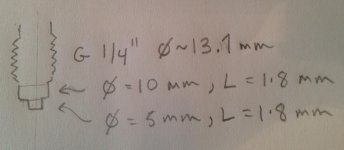ballen
Diamond
- Joined
- Sep 25, 2011
- Location
- Garbsen, Germany
For a one-off project, I need to attach this hydraulic pressure gauge to a chamber in a steel block. The steel is free-machining, unproblematic. Inside is hydraulic fluid, at pressures up to 400 Bar. How do I design the receptacle that this screws into?


The thread is a parallel (non-tapered) 1/4" metric G (Whitworth British Standard Pipe Parallel) intended for strength, but not to seal. So the seal must come from one of two places. Either the short 5mm brass stub should be forced into some type of taper, or the 10mm flat must bear against a trapped sealing washer or o-ring. In either case, I can't just drill an 11.8mm hole and tap it.
One last issue, I would like to be able to orient the gauge in a particular direction. So I presume that the last fitting step will be on the mill, where after screwing and tightening the gauge into place, I calculate how much deeper the faces for the 10mm and the taper for the 5mm stubs should go, then shave off the correct amounts.
I don't have much experience with hydraulic stuff, other than knowing that if the seal isn't well designed, under 400 Bar of pressure, it will leak.
(Don, if I have started this thread in the wrong forum, please move it to the right place.)


The thread is a parallel (non-tapered) 1/4" metric G (Whitworth British Standard Pipe Parallel) intended for strength, but not to seal. So the seal must come from one of two places. Either the short 5mm brass stub should be forced into some type of taper, or the 10mm flat must bear against a trapped sealing washer or o-ring. In either case, I can't just drill an 11.8mm hole and tap it.
One last issue, I would like to be able to orient the gauge in a particular direction. So I presume that the last fitting step will be on the mill, where after screwing and tightening the gauge into place, I calculate how much deeper the faces for the 10mm and the taper for the 5mm stubs should go, then shave off the correct amounts.
I don't have much experience with hydraulic stuff, other than knowing that if the seal isn't well designed, under 400 Bar of pressure, it will leak.
(Don, if I have started this thread in the wrong forum, please move it to the right place.)

